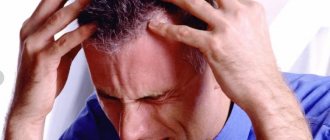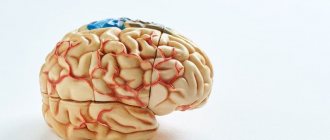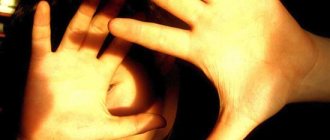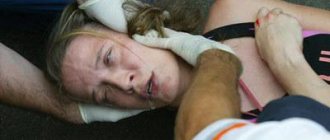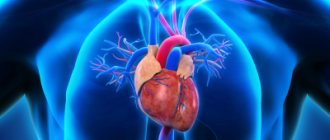What is the provoking factor?
The main reason for the occurrence of SE is the withdrawal of medications taken, the action of which is aimed at suppressing epileptic seizures. However, status epilepticus can occur not only against the background of epilepsy, but also due to brain lesions, including:
- head injury;
- intoxication;
- intracranial malignant tumor;
- circulatory disorders in the brain;
- infection;
- dropsy of the brain (encephalopathy);
- withdrawal syndrome;
- complications of diabetes;
- hematoma.
The incidence of epistatus without a predisposing factor - epilepsy is approximately 50%.
For prevention purposes
Epistatus can be prevented in people suffering from epilepsy by selecting and following the rules of anticonvulsant therapy.
To prevent symptomatic status epilepticus it is necessary:
- provide timely treatment for head injuries;
- do not start treatment of infectious diseases;
- avoid intoxication;
- avoid excessive consumption of alcoholic beverages;
- do not take drugs.
- Is epilepsy curable in adults?
Causes
Seizures occur due to spontaneous discharges sent by the brain
- hereditary factor;
- congenital disorders of the central nervous system;
- brain tumors, both benign and malignant;
- traumatic brain injuries;
- hysteria;
- infectious diseases;
- fever;
- arteriovenous cerebral aneurysms;
- parasitic infestations;
- chronic alcoholism.
Diagnostic measures
- Taking anamnesis (simultaneously with diagnostic and therapeutic measures);
- Examination by an emergency medical technician (paramedic) or a medical specialist from a mobile emergency medical team of the appropriate profile;
- Studying blood glucose levels using an analyzer;
- General thermometry;
- Pulse oximetry;
- Registration of an electrocardiogram, interpretation, description and interpretation of electrocardiographic data.
Find out complaints, collect anamnesis of the disease, pay attention to:
- history of seizures;
- possible cause of the present seizure;
- taking anticonvulsants and their dosage.
Conduct an objective examination and evaluate:
- level of impairment of consciousness (Glasgow scale), breathing, blood circulation;
emphasize on:
- neurological status (presence of cerebral, meningeal and focal symptoms);
exclude:
- TBI, alcohol intoxication, neuroinfection and other diseases leading to seizures.
Forms of convulsive seizure -
- partial (focal, local), consciousness is preserved;
- generalized seizure, consciousness is impaired.
The nature of seizures is tonic, clonic, tonic-clonic.
Issue an “EMS Call Card”. Describe in detail neurological disorders (local status).
Monitoring the general condition of the patient: heart rate, pulse, blood pressure, respiratory rate, ECG, pulse oximetry, glucometry.
What types of pathology are there?
The variability of the types of epileptic seizures determines the formation of various clinical forms of epileptic seizures. They are divided into two main groups - convulsive and non-convulsive seizures.
According to the classification, the following types of status epilepticus are distinguished:
- Generalized SE - characterized by widespread tonic-clonic convulsions with an unconscious state.
- Not completely generalized ES - characterized by atypical muscle spasms with complete loss of consciousness. Tonic status is most common among children with Lennox-Gastaut syndrome. Can be observed at different ages. Clonic status is observed with epilepsy in infants, as well as with convulsions with high fever in young children. Myoclonic status is characterized by constant or episodic muscle twitching.
- The status of focal paroxysms proceeds according to the type of Jacksonian epilepsy with muscle contraction of a certain localization, for example, only the muscles of the face, one limb or half of the body. In this case, loss of consciousness may not occur.
- Absence or non-convulsive status is accompanied by a complete loss of consciousness without muscle contractions. Such attacks are characterized by the mildest course, however, due to the absence of seizures, diagnosis can be difficult.
- Partial status is characterized by unconscious and automatic actions with complete or incomplete loss of consciousness.
The stages of development of epistatus are also distinguished:
- pre-status - lasts 1-10 minutes;
- initial - lasts from 10 minutes to half an hour;
- expanded - lasts from half an hour to an hour;
- refractory - lasts more than an hour.
Seizures may be a sign of a serious disease of the central nervous system. They are divided into:
- Localized seizures. Individual muscle groups are affected.
- Generalized seizures. Covers all muscles. They are a typical manifestation of epilepsy.
- Clonic seizures. Alternating spasms, during which alternating contraction and relaxation of the muscles occur.
- Tonic convulsions. The muscle contraction is prolonged and is not followed by relaxation.
- Tonic-clonic seizures. A combination of tonic and clonic.
The syndrome is manifested by sudden and involuntary muscle contractions
In addition, seizures can occur with:
- traumatic encephalopathy;
- vascular pathologies;
- brain oncology;
- liver failure;
- uremia (intoxication of the body as a result of impaired kidney function);
- hypoglycemic coma;
- neuroinfections (meningitis, encephalitis, polio, leptospirosis, herpes, neurosyphilis)
It is necessary to distinguish between epilepsy and convulsive syndrome (code according to ICD-10 - R56.0). Unlike epilepsy, this pathology is only a symptom and not a separate disease. Its characteristic feature is that after eliminating the underlying disease, the convulsive syndrome itself, which was only a sign of this disease, is also eliminated.
Symptoms and first aid
Manifestations of seizures in adults include involuntary muscle contractions, which can be either generalized (over the whole body) or localized (local). There are also tonic, clonic and mixed (clonic-tonic) seizures. Tonic contractions are long, clonic contractions are short, but with a large interval.
First aid measures for convulsive syndrome should be aimed at preventing injuries. To do this, you need to make sure that the sick person does not fall or hit himself - lay him on a hard surface, place a pillow under his head. You cannot restrain the patient, as this increases the risk of bone fractures and tendon rupture, especially with tetanus.
A convulsive epileptic seizure is characterized by a sudden loss of consciousness, the development of a phase of tonic convulsions with respiratory arrest and bluishness of the face. Involuntary urination and defecation may occur. Tonic convulsions give way to clonic ones. At this stage, breathing is restored, it becomes noisy, hoarse, and foam mixed with blood may be released from the mouth due to biting the tongue. The pupils are dilated and do not react to light. Possible vomiting. The attack lasts 2-3 minutes and often ends with stupor, turning into sleep.
Status epilepticus develops in cases where seizures follow one another so often that the patient does not regain consciousness between attacks. In the absence of adequate treatment, death is possible due to swelling of the brain and lungs, exhaustion of the heart muscle and respiratory paralysis.
What does it look like in real life
Symptoms of status epilepticus are determined by severe disorders in consciousness, respiratory system and hemodynamics, which are caused by a previous attack; the number of seizures during epileptic status can range from 3 to 20 per hour.
Consciousness by the time of the next attack does not clear up and the person is in a state of stupor, numbness or coma.
With prolonged ES, the comatose state worsens, becomes deeper, convulsions take on a tonic form, an increase in blood pressure is replaced by a sharp decrease, and increased reflexion is replaced by a lack of reactions. Hemodynamic and respiratory disorders become more pronounced.
The convulsions may disappear, and then the stage of epileptic prostration begins, which is characterized by external changes:
- pupil size changes;
- the gaze becomes unconscious;
- mouth slightly open.
It is very dangerous! In this condition, death can occur.
Epistatus necessarily lasts more than half an hour. This condition should be differentiated from episodic attacks, during the intervals between which there is a complete or almost complete clearing of consciousness, as well as a partial restoration of the patient’s physiological state.
The course of convulsive SE can be divided into two phases. At the first stage, compensatory changes occur to maintain blood circulation and the metabolic process.
This condition is characterized by:
- tachycardia;
- high blood pressure;
- vomit;
- involuntary urination;
- involuntary defecation.
The second phase occurs after half an hour or an hour and is characterized by a breakdown of compensatory changes. In this state, the following processes occur:
- lowering blood pressure;
- arrhythmia;
- respiratory dysfunction;
- thrombosis of the pulmonary artery and its branches;
- acute renal and liver failure.
Non-convulsive epistatus is characterized by various disorders of consciousness:
- feeling of detachment;
- immobilization.
In the case of ES of complex partial seizures, the following is observed:
- behavioral deviations;
- confusion;
- symptoms of psychosis.
Danger of condition
Very often, epistatus that occurs in children is a sign of the onset of epilepsy, but it happens that convulsive attacks appear already in the later stages of the course of this disease.
In newborns, a seizure occurs with partial loss of consciousness, while the reaction to external stimuli remains intact.
Generalized SE can manifest itself as tonic-clonic, clonic, myoclonic convulsions.
In nonconvulsive SE, electroencephalography is used to detect peak-wave stupor and slow waves, which reflect a state of epileptic stupefaction. Partial ES can be simple, somatomotor, or dysphasic.
In complex partial epistatus, stable preservation of epileptic twilight of consciousness is observed.
The number of attacks can reach several tens or even hundreds per day. In this case, respiratory function and hemodynamics are disrupted, metabolic processes in the brain are disrupted, and the coma state can deepen until death occurs.
Mortality in the case of status epilepticus with previously diagnosed epilepsy is 5%, in the case of symptomatic status - 30-50%. If the ES continues for more than an hour, the following serious consequences may occur:
- cerebral edema;
- oxygen starvation of the brain;
- excessive decrease in blood pressure;
- lactic acidosis - excessive accumulation of lactic acid in the body;
- electrolyte imbalance;
- mental retardation and mental retardation in children.
Non-convulsive SE is less dangerous than generalized SE, however, in this case, cognitive impairment may develop.
Cheat sheet when applying for a calling card for a patient with epilepsy
The call card for epilepsy indicates the patient's complaints at the time of examination.
The documentation reflects the following points:
- the nature of the convulsions (if they are conscious);
- the patient’s feelings before the attack;
- the presence of a bite injury on the tongue;
- presence of involuntary urination;
- presence of headache;
- the presence of dyspeptic symptoms (nausea, vomiting);
- the presence of sensitivity disorders and paresis;
- the presence of general weakness;
- presence of speech, vision, and cognitive impairments.
Anamnesis
The medical history in the emergency call card for epilepsy includes items such as:
Time of seizure onset (how many hours/minutes ago).
- Nature of seizures (partial, generalized).
- The sequence of appearance and dynamics of symptoms or complaints that became the reason for calling the emergency medical team or identified during a medical examination.
- Did the patient fall during the attack? If you fell, did you hit your head?
- Events that triggered the seizure.
- Frequency of seizures.
- Anticonvulsant medications taken by the patient.
- Concomitant pathologies (if any).
Also, the call card for epistatus indicates the source of the information received - from the words of the patient, eyewitnesses, from the outpatient card, discharge summary from the hospital. If the source of information cannot be established, it is necessary to indicate that a reliable history is unknown.
Additionally, the call card for convulsive syndrome indicates whether the allergy history is aggravated, and in women - if there is additional information regarding the gynecological history (diseases, surgical interventions, etc.). If the patient has an elevated body temperature, his epidemiological history should be clarified.
- In this article you will find only a few ready-made samples and templates. There are more than 5000 of them in the Consilium System.
Male, 36 years old. The reason for the call is that he is unconscious on the street, the reason has not been established (passers-by call).
At the time of inspection, he makes no complaints about what happened and doesn’t remember. He is located on the street near the store, sitting on the porch.
According to others, about 10-15 minutes ago there was an attack of tonic-clonic seizures with loss of consciousness and foam at the mouth. No treatment was undertaken. This is not the first time this has happened; I previously went to the emergency room for epileptic seizures.
First aid
The main goal when providing first emergency care in case of epistatus before the arrival of doctors is to prevent damage and trauma to the patient.
What to do during an attack:
- lay the person on a comfortable surface to reduce the risk of injury;
- remove those items of clothing that may cause discomfort (for example, a tie, a belt), unbutton the collar;
- place rolled clothing under your head;
- carefully turn your head to the side so that the patient does not choke on his saliva;
- if your mouth is slightly open, you need to put a handkerchief or some kind of cloth between your teeth, but in no case a sharp object, so as not to break your teeth;
- remove all dangerous objects that are in the immediate vicinity to avoid injury;
- do not hold the person too tightly, otherwise there is a high risk of broken bones;
- do not open your teeth if they are clenched.
Unfasten the collar and belt, protect from bruises. To prevent tongue bite, insert a corner of a towel or the handle of a spoon wrapped in several layers of fabric between the molars. Turn your head to the side while vomiting. If necessary, clear your mouth of mucus and vomit. You should not try to wake the patient or give any medicine by mouth.
Emergency care for seizures
The main goal when providing first emergency care in case of epistatus before the arrival of doctors is to prevent damage and trauma to the patient.
What to do during an attack:
- lay the person on a comfortable surface to reduce the risk of injury;
- remove those items of clothing that may cause discomfort (for example, a tie, a belt), unbutton the collar;
- place rolled clothing under your head;
- carefully turn your head to the side so that the patient does not choke on his saliva;
- if your mouth is slightly open, you need to put a handkerchief or some kind of cloth between your teeth, but in no case a sharp object, so as not to break your teeth;
- remove all dangerous objects that are in the immediate vicinity to avoid injury;
- do not hold the person too tightly, otherwise there is a high risk of broken bones;
- do not open your teeth if they are clenched.
Brief recommendations will help you react quickly if a person has a seizure disorder. Your actions are:
- Place the patient on a flat, non-hard surface if possible.
- Remove all sharp and hard objects from reach. This will help avoid injury due to uncontrolled limb movements.
- Unfasten or remove tight clothing that may impede breathing. If you're indoors, open the windows to let in fresh air.
First aid before doctors arrive is of great importance in this condition, and its absence can be fatal
- Gently turn the victim's head to one side and hold it slightly to prevent the tongue from retracting and vomit from entering the respiratory tract.
- Remember that in no case should you hold the patient by force, you can only hold him a little, you should not try to open clenched jaws, and between the teeth (if they are not closed) place a non-solid object, for example, a tourniquet rolled up from fabric. In this condition, the victim’s muscles are very tense, and excess pressure can lead to a bone fracture.
- When the attack is over, do not leave the patient unobserved. Call an ambulance, briefly clarifying what happened to the victim.
Convulsive syndrome is the body’s reaction to external and internal stimuli, characterized by sudden attacks of involuntary muscle contractions
Convulsive syndrome in men, women and children is a nonspecific reaction of the body to internal and external stimuli. It is accompanied by involuntary contraction of muscle tissue.
The international classification of diseases includes convulsive syndrome. Its ICD-10 code is R56.8. This code is reserved for pathologies that do not relate to seizures of epilepsy or other etiology.
Convulsive syndrome often occurs in newborns. It affects adults of all ages. It is very important to find out the cause of the disorder in order to select an adequate course of therapy.
Reasons for violation
Convulsive syndrome is caused by various reasons. Quite often it develops due to congenital anomalies and pathologies of the central nervous system. Common factors also include genetic diseases, tumors in the body, and cardiovascular problems.
Common causes that lead to the appearance of the syndrome are presented in the table. They are divided by age groups.
| Age | Reasons for violation |
| Up to 10 years | Convulsions in childhood are caused by diseases of the central nervous system, fever, head injuries, congenital abnormalities in metabolism, cerebral palsy and epilepsy. |
| 11-25 years | The cause of the disease is head injuries, angioma, toxoplasmosis and neoplasms in the brain cavity. |
| 26-60 years | Pathology can be caused by neoplasms in the brain, inflammatory processes in the membranes of this organ, and abuse of alcoholic beverages. |
| From 61 years old | Seizures can be caused by kidney failure, drug overdose, Alzheimer's disease, and cerebrovascular disorders. |
Since convulsive syndrome in an adult or children has many causes, the methods of treating such a disorder differ. To achieve recovery, it is necessary to correctly determine the factor that led to the development of the disease.
Convulsive syndrome in children and adults has similar symptoms. Pathology appears suddenly.
A typical seizure is characterized by eye floaters, wandering eyes, and loss of contact with the outside world.
The tonic phase of the attack is characterized by short-term apnea and bradycardia. The clonic phase is characterized by twitching of facial areas on the face.
With alcoholic convulsive syndrome, which often occurs in adults and adolescents, severe intoxication, loss of consciousness, vomiting and foam from the mouth appear.
Convulsive syndrome in young children and adults is localized or generalized. In the first case, during an attack, individual muscle groups are involved. In the generalized course of the syndrome, the child may experience involuntary urination and loss of consciousness. Due to pathology, all muscle groups suffer.
Convulsions are characterized by an acute onset, agitation, and changes in consciousness
Spastic pathology, which is the state of convulsive syndrome, poses a danger to human health and life. If the attack is not suppressed in a timely manner and treatment of the disease is ignored, it will lead to dangerous consequences:
- Pulmonary edema, which threatens complete cessation of breathing.
- Cardiovascular pathologies that can lead to cardiac arrest.
Manifestations of an attack can overtake a person while he is performing actions that require maximum concentration of attention. We are talking about driving a vehicle. Even walking can cause serious injury if an adult or child is suddenly disturbed by the signs and symptoms of a seizure disorder.
Manifestations of seizures in adults include involuntary muscle contractions, which can be either generalized (over the whole body) or localized (local). There are also tonic, clonic and mixed (clonic-tonic) seizures. Tonic contractions are long, clonic contractions are short, but with a large interval.
First aid measures for convulsive syndrome should be aimed at preventing injuries. To do this, you need to make sure that the sick person does not fall or hit himself - lay him on a hard surface, place a pillow under his head. You cannot restrain the patient, as this increases the risk of bone fractures and tendon rupture, especially with tetanus.
To help the patient, it is necessary to urgently call an ambulance
Convulsive syndrome, which manifests itself in a child or an adult, cannot be ignored. Adequate treatment is required.
Before deciding on therapy, a specialist must find out the cause of the disease. It is for these purposes that diagnostics are used. The therapy offered by attending physicians is aimed at suppressing the symptoms of the pathological process and eliminating the negative factor that led to the development of the syndrome.
Urgent Care
First aid can be provided to a patient at the time of an attack by anyone. He must recognize the obvious symptoms of the disease and quickly respond to them. To avoid injury to the patient during seizures, it is necessary to act accurately and consistently.
First aid to a person with a convulsive syndrome helps him wait for the medical team to arrive and safely survive the painful condition. If infants, adolescents or adults experience symptoms characteristic of an attack, you should immediately call an ambulance. Next you need to do the following:
- It is necessary to provide the victim with access to fresh air. To do this, if possible, remove tight clothing or unbutton his shirt.
- It is necessary to place a small towel or scarf in the oral cavity so that the person does not accidentally bite his tongue or break his teeth.
- The patient's head should be turned to the side. The same must be done with his entire body. This action will prevent him from choking on vomit.
All these actions must be done very quickly. Afterwards, all that remains is to wait for the arrival of doctors who will help the person get rid of the attack.
Drugs
Taking sedatives helps the patient reduce the occurrence of seizures
Emergency care for a person with a seizure disorder may include taking medications. Drug therapy is aimed at eliminating the attack and further preventing this condition.
For convulsions, agitation and epileptic seizures, patients are prescribed GABA derivatives, barbiturates and benzodiazepines. Medicines help calm the nervous system and reduce muscle tone. For acute conditions, antipsychotics may be prescribed.
For cramps in the limbs, vitamin complexes can be prescribed. This therapy is effective if the attack is triggered by hypovitaminosis.
Providing assistance for convulsive syndrome includes the use of oral and external agents. For seizures, the following medications are recommended:
- Vitamins B and D.
- Magnistad.
- Magnerot.
It is strictly forbidden to give a baby or an adult medicine that has not been prescribed by a specialist. Medicines can be taken strictly on the recommendation of the attending physician. Otherwise, such therapy may lead to complications.
External remedies for the treatment of attacks include ointments. For leg cramps, it is customary to prescribe:
- Hermes.
- Troxevasin.
- Venitan.
Ointments and creams reduce the severity of seizures, stimulate blood circulation in the problem area and improve the saturation of tissues with nutrients.
Status epilepticus: what is this condition and why is it dangerous?
The most serious complication of epilepsy is status epilepticus.
In this condition, one epileptic seizure is replaced by another, preventing the patient from regaining consciousness.
The patient has a progressive disorder of the central nervous system, since it does not have time to recover from the previous attack.
Causes of pathology
Status epilepticus manifests itself as a complication of epilepsy, but can also be its manifestation. The attacks last more than 30 minutes and pose a direct threat to human life.
Epistatus most often develops in the symptomatic form of epilepsy; it can also occur in idiopathic form.
It is necessary to differentiate status epilepticus from serial epileptic seizures, between which the patient’s consciousness is restored and there is no disruption of the functioning of organs and systems. However, serial seizures can lead to epistatus.
The disease occurs due to continuous electrical activity of brain neurons. Pathological excitation spreads through the neural circuits that support this activity.
It turns out to be a vicious circle that is not easy to break. The difference between epistatus and a generalized attack is that the latter has clearly defined phases: tonic and clonic.
In status epilepticus, these phases cannot be distinguished. The patient is unconscious and has complete areflexia.
The causes of the disease may be:
- abrupt cessation of taking antiepileptic drugs;
- simultaneous use of anticonvulsants and sedatives or hypnotics;
- drinking alcohol;
- neoplasms in the brain;
- strokes;
- head injuries;
- infections (encephalitis, meningitis, polio, influenza);
- hypoglycemia;
- intoxication due to exposure to harmful chemicals;
- dysmetabolic disorders (uremia, hyponatremia);
- acute renal and adrenal failure.
Thus, the occurrence of pathology is not always associated with epilepsy. Children are more susceptible to the disease.
Sometimes such attacks in children are a consequence of severe influenza, when the temperature rises to critical levels.
Often in children, epistatus indicates congenital pathologies of brain development.
Classification, symptoms and clinic
In medicine, there are several types of status epilepticus depending on the type of seizure:
- Generalized ES of extensive (convulsive) seizures. This is a series of seizures with tonic and clonic convulsions and complete loss of consciousness.
- Generalized absence seizure syndrome. In this case, the attacks are regularly repeated, but the patient does not experience convulsions. Consciousness can be switched off (like a coma) or maintained. In this case, the attacks occur unnoticed by others. The patient appears a little strange, but is able to perform normal activities. There are cases of patients staying in this state for more than a day. The person has slight lethargy and confusion.
- Partial ES. There are two types:
- ES of simple partial seizures. Usually they are preceded by an aura: the appearance of smells, sensations of sounds. This lasts a few seconds, the patient does not have time to complain about his condition. Then the patient begins to twitch the corners of the mouth, tongue, and facial muscles, then the spasms spread to the whole body;
- ES of complex partial seizures. They represent a combination of twilight consciousness with automatisms (uncontrolled actions). This could be: swallowing or chewing movements, rubbing hands, meaningless speech, sleepwalking. The patient may run somewhere, knocking over everything in his path. Such attacks last about 40 minutes, followed by complete amnesia.
- Neonatal ES. Occurs in children in the first days of life. It is characterized by the occurrence of a series of flexion and extension movements, throwing back the head, and rolling the eyes.
- Initial ES. Characterized by sudden loss of consciousness, screaming and convulsive contractions of the chest.
- Clonic ES. It may be a consequence of epilepsy or occur with a strong increase in temperature (in children). Contractions of the muscles of the limbs, noisy breathing, biting the tongue, and convulsions are observed.
- Tonic ES. More common in children with epilepsy. It begins with muscle hypertension, throwing back the head, and stopping breathing.
- Myoclonic ES. Convulsions occur in the upper part of the body (arms, head, shoulders twitch). The patient may be conscious.
- ES of convulsive seizures. Occurs most often. After one attack, consciousness does not return or returns partially, then the attack develops again. The muscle contractions are so strong that they can cause bone fractures. The patient clenches his teeth, arches his back, and foams at the mouth. Often an epileptic screams during an attack from severe pain. After the seizures stop, a coma sets in, consciousness does not return, and a new attack begins.
Emergency care during an epileptic attack
Status epilepticus requires emergency care and intensive care.
The attack must be stopped urgently, otherwise the death of brain neurons will occur, since excitatory amino acids are continuously released.
First aid algorithm for a patient:
- Call an ambulance.
- Ensuring airway patency (removing dentures, clearing vomit).
- Protecting the patient from injury. The patient should be laid on a soft surface, head turned to one side, and a pillow placed under the head.
- If breathing stops, perform artificial respiration and chest compressions.
In the intensive care unit, the patient is connected to a ventilator, if necessary. Then a solution of glucose and thiamine is administered. They also do blood tests for sugar, electrolytes, alcohol, drugs, and kidney and liver tests.
To stop the attack, Diazepam solution is administered intravenously. A single administration is usually sufficient.
Drugs for treatment and relief agents
Pathology therapy is selected depending on the cause. If the cause lies in a brain tumor, then the issue of surgical removal of the formation is resolved.
In other cases, the following drugs are administered to the patient:
- Anticonvulsants : Diazepam is a tranquilizer with anticonvulsant, anti-edematous action. Muscle relaxant. Sibazon is a muscle relaxant with a sedative effect.
- Diuretics (to prevent brain swelling). Mannitol. Acetazolamide.
- Barbiturates . Phenobarbital is an anticonvulsant sedative drug. Suppresses the sensory area of the cerebral cortex.
Along with anticonvulsants, the patient is administered drugs that support vital functions:
- Corticosteroids (Prednisolone). Indicated for diabetes, poisoning, infections.
- Blood pressure lowering agents (Clonidine).
- Cardiovascular drugs (Eufillin).
- Stimulating respiratory function (Cordiamine).
- Preventing blood clotting (Curantil, Heparin).
- Vitamins (B6).
If the attack cannot be stopped within an hour, then the patient is given general anesthesia with Thiopental or Propofol. Anesthesia is continued for 24 hours after the last attack.
When ES is stopped, the patient is prescribed therapy according to the severity of the complications. If the status is caused by epilepsy, then the patient requires lifelong use of antiepileptic drugs.
Thus, ES therapy is carried out in several stages:
- Stopping an attack.
- Determining the cause of the pathology.
- Administration of anticonvulsants.
- Symptomatic help.
- Detection and treatment of complications.
- Prescription of long-term treatment.
About the treatment of epistatus in this video:
Consequences
Status epilepticus is a life-threatening condition. Continuous attacks lead to disorders of all organs and systems:
- Due to respiratory arrest, oxygen does not reach the brain, hypoxia occurs.
- During an attack, the swallowing reflex is disrupted, and stomach contents can enter the respiratory tract and lead to suffocation.
- With each attack, blood pressure and heart rate increase to critical levels. The patient may have a stroke or heart attack, or develop acute heart failure.
- During constant cramps, muscle fibers break down. Decay products enter the kidneys with the blood, clogging the tubules and complicating urination.
- Due to hypoxia, respiratory failure and pulmonary edema develop.
- During seizures, bone fractures or serious injuries are common.
- Due to blood thickening, blood clots form. The patient may die from thromboembolism.
- The most serious and rapidly developing complication is cerebral edema. Death from this happens within a few minutes.
- Children often experience stunted physical and mental development.
Prognosis and clinical recommendations
The prognosis of the disease depends on the cause, duration and type of attacks.
In epilepsy, the mortality rate from epilepsy is 5%.
If epistatus is caused by other reasons, then the death rate is 40-50%. The death of the patient usually occurs from cerebral edema, pulmonary edema, or cardiac arrest.
In those patients who managed to survive, in 40% of cases irreversible changes occur in the brain, which leads to mental disorders and serious neurological disorders.
Prevention of the disease is as follows:
Status epilepticus is a condition that seriously threatens the patient's life. It requires emergency care, resuscitation and intensive care.
The outcome of the disease will depend on timely and correct treatment.
Status epilepticus from A to Z:
Source: https://nerv.guru/zabolevaniya/epilepsiya/pristup/epilepticheskij-status.html
Further actions
Relief of status epilepticus is carried out through the following measures:
- ensuring airway patency;
- use of oxygen therapy;
- intravenous injection of Diazepam (maximum daily dose - 40 mg), a side effect of this drug may be respiratory depression.
Further therapy is carried out by administering medications depending on the stage of status epilepticus.
At the initial stage, the following drugs are used to relieve status epilepticus:
- Diazepam;
- Lorazepam;
- Depakine;
- Feniton;
- Oxybutyrate.
Among the side effects of treatment, the following consequences can be identified: arterial hypotension, acute toxic hepatitis, phlebosclerosis, hypokalemia. At the advanced stage of ES, the following is used:
- Diazepam;
- Lorazepam;
- Phenobarbital;
- Sodium thiopental.
At the refractory stage of ES, the following measures are carried out:
- Intubation, correction of electrolyte disturbances, transfer to artificial ventilation of the lungs - to maintain vital functions of the body.
- Barbiturate anesthesia - intravenous injection of sodium thiopental for 20 seconds. 100-250 mg of the drug is administered. If the patient's condition does not improve, a dose of 50 mg is administered every few minutes until the seizure stops. Barbiturate anesthesia can last from 12 hours to a day.
- Dexamethasone and Mannitol injections are given to prevent cerebral edema.
- Infusion dehydration therapy is carried out to eliminate disorders of liquor dynamics and the metabolic process. For this purpose the following are used: Magenzia, Lasix, Cordiamin, Eufillin, Korglykon.
In the event that the epistatus is symptomatic, that is, it arose against the background of brain damage, a neurosurgical operation should be performed to compress the brain vessels.
First aid
Medical Center
The activities of the previous stage are being carried out. If there is no effect, administer 50 ml of a 4% solution of chloral hydrate using a microenema or intramuscularly 2-3 ml of a 2.5% solution of aminazine with 1-3 ml of a 1% solution of diphenhydramine and 5-10 ml of a 25% solution of magnesium sulfate under blood pressure control. For symptoms of cardiovascular failure - 1-2 ml of a 20% caffeine solution subcutaneously.
Evacuation to the hospital (medical hospital) by ambulance, in a lying position on a stretcher, accompanied by a doctor and two orderlies (soldiers).
Omedb, hospital
In addition to the above measures, 3 ml of 0.5% seduxen solution in 150 ml of 10-20% glucose solution, 10-20 ml of 10% sodium hydroxybutyrate solution are administered intravenously. If there is no effect from repeated injections of seduxen and sodium hydroxybutyrate (the total dose of seduxen should not exceed 100-120 mg, and sodium hydroxybutyrate - 250 mg/kg per day), a 2.5% solution of sodium thiopental or hexenal is slowly injected intravenously up to 20-30 ml. In case of respiratory depression - tracheal intubation and mechanical ventilation. Inhalation anesthesia with nitrous oxide mixed with oxygen in a 2:1 ratio can be used.
If the measures taken do not relieve status epilepticus, long-term inhalation anesthesia with the use of mechanical ventilation and muscle relaxants is used.
If congestive optic discs and dislocation phenomena are excluded according to echoencephalography, a lumbar puncture is indicated with the removal of 20-30 ml of cerebrospinal fluid.
According to indications, correction of heart failure, acid-base disorders, and cerebral edema is carried out. Treatment of the underlying disease.
Nechaev E.A.
Instructions for emergency care for acute diseases, injuries and poisonings. Part I
Published by Konstantin Mokanov
Therapeutic measures
For a generalized or focal seizure with a brigade:
- Diazepam - 0.15 mg/kg IV bolus slowly;
- In case of repeated convulsive seizure with the team:
- Diazepam - 0.15 mg/kg IV bolus slowly;
- Magnesium sulfate - 2500 mg IV bolus slowly;
- Medical evacuation according to indications (see “General tactical measures”).
For a generalized or focal seizure, up to the brigade:
- At SBP level {amp}gt; 180mmHg:
- Magnesium sulfate - 2500 mg IV bolus slowly,
At SBP level {amp}lt; 180 mmHg:
- Magnesium sulfate - 2500 mg IM;
- Medical evacuation according to indications (see “General tactical measures”).
Attack at the EMS brigade.
During an attack, prevent TBI.
Ensure patency of the upper respiratory tract.
Carry out anticonvulsant therapy:
- Diazepam (Seduxen) 10-20 mg IV;
- Magnesium sulfate 25% -10 ml IV slowly.
After an attack, maintain patency of the upper respiratory tract.
The EMS team arrived after independently stopping the attack:
- Magnesium sulfate 25% -10 ml IV slowly.
In the normal course of the disease, give recommendations to patients left at home:
- bed rest for 6-8 hours after the attack;
- minimize physical and sensory stress;
- control blood pressure whenever possible;
- continue taking anticonvulsants;
- consultation with a local therapist, neurologist to clarify further treatment of epilepsy.
In case of a series of epileptic seizures or the development of epistatus, taking into account the peculiarities of the work of this health care facility, call a specialized emergency medical service team.


